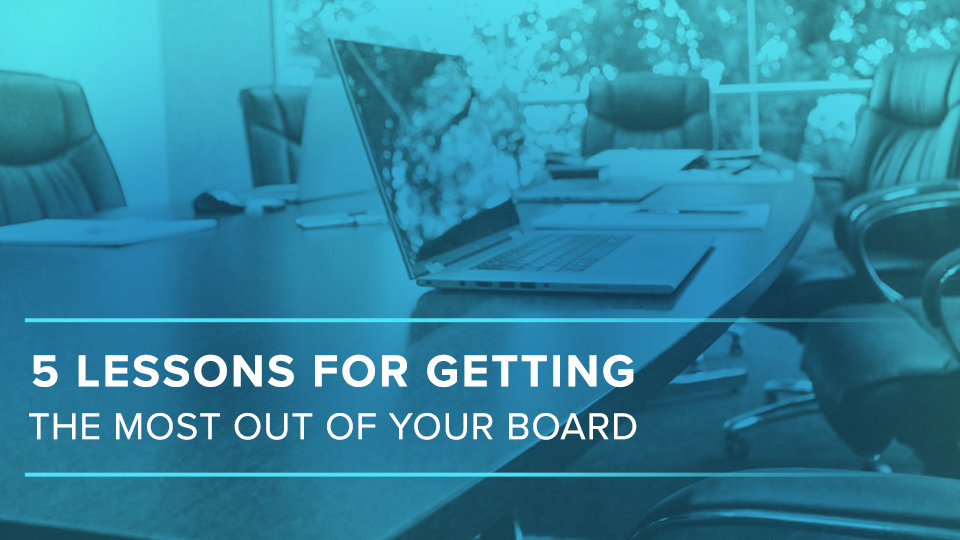5 Lessons for Getting the Most out of Your Board
By Pete Wilson
For the past 20 years, I’ve been working with nonprofit boards of all shapes and sizes. I’ve started two nonprofits where I reported to a board and then also served on several other nonprofit boards over the years for different organizations.
I can tell you that my experience with boards, for the most part, has been very positive. And the times that it wasn’t, I can point to mistakes I made along the way.
So, here are five lessons that can help make you lead your board more effectively:
Lesson #1: The Meeting Starts Before the Meeting
Your board of directors meeting doesn’t actually start when everyone sits down around the table- your work actually starts long before then. Prior to the meeting, you need take care of the logistics to make the time run smoothly and allows you to capitalize on the voices in the room.
Years ago, I discovered that we spent a lot of precious time reviewing documents that easily could have been reviewed before the meeting had we sent them out in advance.
When we started sending out regular reports in advance, like financials and such, the board could review it prior to the meeting which led to faster and more effective meetings and our board started showing up with notes and questions prepared.
It also helped keep surprises to a minimum. I never wanted board members to feel surprised by large proposals or controversial items. Catching them off-guard with such things was rarely beneficial. They always handled it better when they had time to think through and carefully weigh the best path to move forward.
Lesson #2: Create written roles and responsibilities.
This might have been my biggest mistake early on. I started two nonprofits from the ground up, which meant that in both cases the role of the board was not only not defined but was also rapidly changing by the month. Early on in both startups, the board played an important decision-making role, but over time as we added staff they became more of an advisory group. If the changing responsibilities haven’t been clearly defined you can imagine the kind of confusion that would create by all involved.
Develop a concise document that clearly delineates the roles and responsibilities of the board and those of the executive director. This will provide defined parameters and boundaries so that all key players understand their functions. If this doesn’t exist, you run the risk of your board always wondering if they’re actually being successful- and even worse, you have them overstepping their roles and creating sideways energy. In either case, they’re not to blame if their roles and responsibilities have not been clearly defined.
Lesson #3: Work them!
This may be the most counterintuitive of all the lessons I’ve learned. The best way to retain your busiest, most valuable board members is to give them more work. Yes, they’re already busy and you don’t want to overwhelm them but if they don’t see their roles as critical to your nonprofit’s success, they will drift toward something else where they can make a greater impact.
Along these same lines, you don’t want to attract board members that just want to attend meetings. There’s a big difference between attending a meeting and engagement. Set the bar high and expect a lot out of your board.
Lesson #4: Involve other staff with the board.
This is another lesson I had to learn the hard way. For years, I was the only staff person who had contact with our volunteer board. I made the mistake of thinking that I was really the only one who needed to have influence with them and had convinced myself that I was doing my staff a favor to keep them away from the board.
The problem was I made the board completely dependent on me, which never transferred trust to the rest of my staff. Over time, I started introducing members of my executive team to our board by allowing them to give monthly reports and answer questions the board had for their specific areas. This led to a higher level of trust between the two groups and eventually led to greater momentum and a larger body of work being accomplished.
That being said, I still think it’s important to have a closed session of the board that is just the board to discuss board-only matters.
Lesson #5: Ask for help — Your board’s distance can provide perspective.
There’s no doubt that you know more about leading your nonprofit than your board likely does.
No matter how large or profitable that CEO is on your board, the reality is, leading a for-profit company is much different then leading a nonprofit. We know that well at The A Group. We understand that you have unique challenges and have designed a company around meeting the unique needs of a nonprofit.
And you’re right, your board members are not in the day to day grind of the organization like you are. But that’s the point. Their distance from the day to day can actually provide valuable perspective.
And if you’re in a season where your board isn’t necessarily equipped to help walk you down paths that lead to change and future growth, we can be that for you. We can indeed bring an outside perspective, but most importantly- it will be strategic perspective that will make a difference in your organization. And it all begins with StratLab. What’s that, you ask? You’re in for a treat. Check it out.














